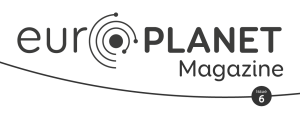Commkit: The Dream of AI
Thibaut Roger (University of Bern, Switzerland) examines how AI can be useful for scientific outreach and communication, as well as the limitations.
Read article in the fully formatted PDF of the Europlanet Magazine.
This issue of the Europlanet Magazine has delved into the ways that Machine Learning and other Artificial Intelligence (AI) processes can benefit science. But what about science communication and outreach? Can AI help you overcome your artistic or literary challenges to finally grasp your dream of creating magnificent illustrations or flawless prose?
Text Applications
AI struggles with the complexity of scientific or technical language. In my experience, correcting AI-generated content can end up taking much longer than doing the work from scratch, in particular for translations. Recently, a colleague showed me some ‘improvements’ suggested by ChatGPT for a press release. With the proposed changes, the phrase “a simple process, very complicated to reverse” would have become “a highly complex process”; ChatGPT did not get the point that it was the reversal that is complicated and not the process, which on the contrary is simple. The meaning was changed. Issues can also arise from AI being essentially a dictionary of synonyms. For example, AI is unable to distinguish between “power” and “intensity”; these words can be synonyms in common language, but they are two very distinct scientific notions.
Image Applications
Using AI in communication to generate images and illustrations seems useful, but it also raises important ethical (and legal) concerns. While some AI-powered content generators, such as Adobe Firefly, disclose the composition of their training set, most do not. Concerns about training on copyrighted material actually led EurekAlert!, a major tool for press release publication, to ban any AI-generated content. AI also tends to repeat representation biases, such as diversity biases or common stereotypes (e.g. a scientist = a white man wearing lab coat).
Benefits
At this stage, AI still needs a human to check and correct the results. However, with short and simple texts (e.g. translations of newsletters) it definitely can save you time. Recently, I tried to use AI to generate a cutaway view of Mars showing the planetary interior. While the results were ludicrous, they actually inspired me to create my own illustration with an unconventional cutaway (see above), rather than the traditional ‘orange-segment’. Despite its flaws, AI-generated or improved content can serve as a source of inspiration and provide a different take on things.


Right: My illustration, inspired by the AI-generated example
Planetarily yours,
Thibaut
If you have science communication tips and tricks to share, join the conversation on Discord.


